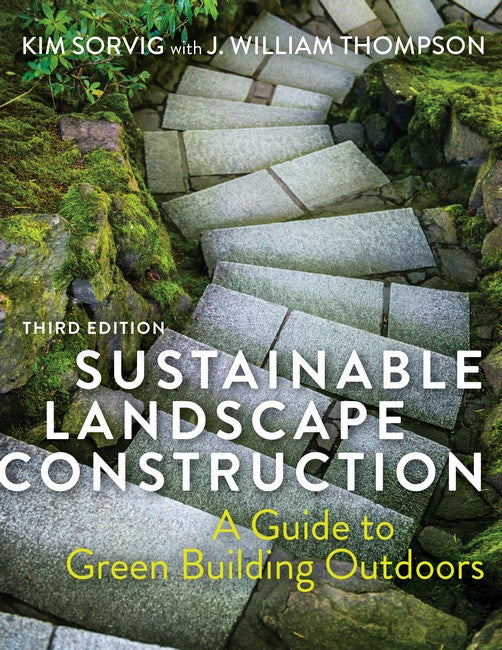Contents
List of Figures
List of Tables
Preface to the Third Edition
Authorship Changes
Why a New Edition?
Whats New in This Edition?
Who Should Use This Book?
How to Use This Book
Finding Landscapes Along the Information Highway
Acknowledgments
Contacting the Author
Basic Principles: "Sustainability" in Context
What Is Sustainability? Politics, Ethics, and Semantics
Sustainability: Convention, Tradition, and Innovation
Landscapes Against Climate Change
Sustainability, Substance, and Style
Rethinking Special Landscape Types for Sustainability
Principle 1: Keep Healthy Sites Healthy
What Is a Healthy Site?
Take a Role in "Pre-construction"
Do Your Homework First: Knowledge as Sustainability
Avoid Survey Damage
Minimize Utility Damage
Physically Protect Sites During Construction
Preserve Healthy Topsoil
Save Every Possible Existing Tree-- Even Just One
Use Appropriate Construction Machinery
Related Design and Planning Issues
Coordination and Follow-Up
Principle 2: Heal Injured Soils and Sites
Turn Wastelands to Gardens
Balance the Environmental Costs and Benefits of Restoration
Involve the Community in Site Restoration
Make a Virtue of the Necessity for Landfills
Recognize Agricultural and Rural Restoration
Restore Lanscapes Structurally
Restore Damaged Soils On-site
Restore Regionally Appropriate Vegetation
Restore Forests and Coexist with Wildfire
Principle 3: Favor Living, Flexible Materials
Highlight the Benefits of Vegetation
Hold Slopes in Place with BTEC-- Biotechnical Erosion Control
Make Vertical Structures "Habitat-able" with Greenwalls
Turn Barren Roof Space into Greenroofs
Construct for and with Plants
Evaluate Turf: The Green, the Bad, and the Ugly
Count on Plants to Sustain
Principle 4: Respect the Waters of Life
Work with the Sites Water Regime
Understand, Protect, and Restore Natural Wetlands
Know the Issues Before Working in or near Wetlands
Restore Rivers and Streams to Full Health
Collect and Conserve Water
Irrigate Intelligently and Sparingly
Reuse Graywater
Purify Water at Every Opportunity
Test Modern Hardware for Cleaner Piped Stormwater
Let Constructed Wetlands Treat Water
Principle 5: Pave Less
Plan and Design to Reduce Paving
Take Advantage of Context-sensitive Road Design
Use Techniques That Reduce Runoff from Paving
Use Porous Paving Materials
Cool Asphalt with Planting and Albedo
Principle 6: Consider Origin and Fate of Materials
The Devil Is in the Design
Recall Some Simple Guidelines
Let Reuse Be Re-inspiration
Use Local, Salvaged, or Recycled Materials
Evaluate Environmental Costs When Choosing Suppliers
Use Sustainably Harvested Renewables
Use Nonrenewable Materials Sparingly
Avoid Toxic Materials
Know General Toxicity Issues by Material Type
Avoid Three Controversial Materials
Prioritize Hazard-reduction Efforts
Principle 7: Know the Costs of Energy over Time
Understand How Landscape Energy Use Is Different
Manage Energy for Machines, Tools, and Labor
Embodied Energy-- Why Do We Care?
Use Life-cycle Costing to Justify Sustainable Design
Apply Guidelines for Landscape Energy Conservation
Principle 8: Celebrate Light, Respect Darkness
Respect the Need for Darkness
Talk Lighting-- a Brief Glossary
Use Lighting Efficiently
Try Low-voltage Lighting for Flexibility
Use Solar Lighting
Evaluate Lamp Performance
Join LED Lighting Revolution
Principle 9: Quietly Defend Silence
Understand Noise Terminology
Be Aware of Damage Cause by Noise
Dont Rely on Noise "Barries" in Most Landscapes
Try Noise-absorbing Materials
Modify Pavement to Reduce Road Noise
Make Noise Invisible
Fight Noise with Noise
Push for Quieter Landscape Tools
Protect "Soundscapes" Through Planning
Principle 10: Maintain to Sustain
Know the Resource Costs of Conventional Landscape Maintenance
Plan for maintainable Spaces
Expect Change
Evaluate Bio-based Maintenance Products with Care
Apply Integrated Pest Management
Use Fertilizers Sustainably
Dont Waste On-site Resources
Consider Alternatives to Mowing
Adapt to Using Native Plants
Manage Large Public Landscapes Holistically, Too
Evaluate Life-cycle Costs of Maintenance Options
Use Innovative Funding
Coordinate Design, Construction, and Maintenance
Principle 11: Demonstrate Performance, Learn from Failure
Anatomy of a Certification System
Landscape Certification Programs
Better Measures
Landscape Forensics and Learning (or Not) from Failure
Sustaining Principles, Evolving Efforts
Learning from the Landscape: Themes and Strategies
Green Education in Design and Construction
Landscapes as Public Environmental Education
Thinking One Hundred Years Ahead
Notes
Index

